You’re a Bass Player, you’ve been rocking for a while, laying down those funky bass lines or just jamming with your mates, but you started to feel like something in your tone is lacking, that you could do more. The answer probably isn’t a new bass or a new amp or an 8×10” bass cabinet.
It could be as simple as getting a small pedal or two. It rarely stops at one or two though. Buying pedals can get really addictive really fast due to their relatively low cost (except vintage pedals or the boutique variety) and small size. They are also easier to hide from your significant other than said new bass or 8×10” cab, but the fun and joy they bring is virtually limitless.
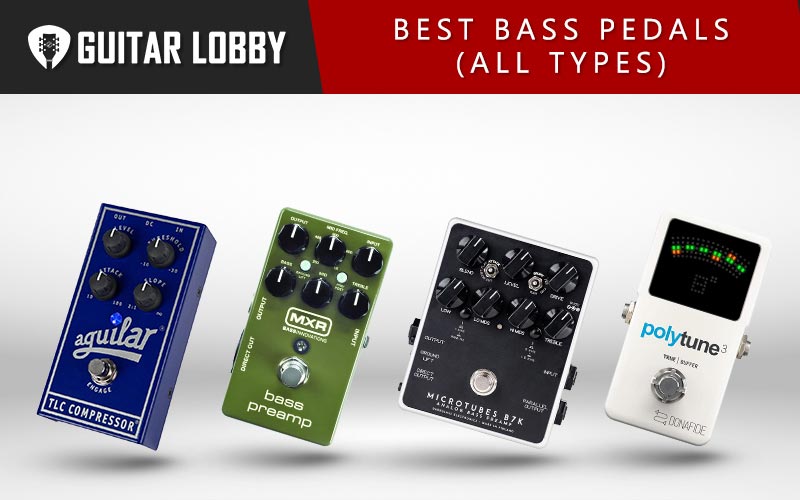
There are lots of options and it can get a little confusing. Don’t worry, though, over the years I’ve tested dozens of pedals, and below I’ll be sharing the best bass pedals in each category. I’ll start by jumping straight into reviews, but if you want to learn more about them or how to choose the right type before reading reviews, check out our bass pedal information guide at the bottom of the page here.
| Name of Product | Image of Product | Type | Price Range | Full Review |
|---|---|---|---|---|
| 1. TC Electronic Polytune 3 (Best Overall Tuner) | 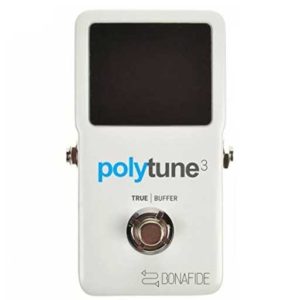 | Tuner | $100 | Read Full Review Below |
| 2. Behringer TU300 Chromatic Tuner Pedal (Best Cheap Tuner) | 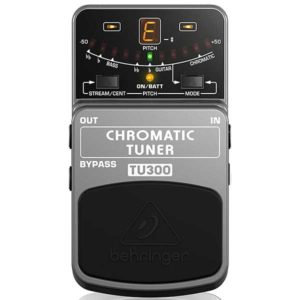 | Tuner | $30 | Read Full Review Below |
| 3. Korg Pitchblack Advance (Best Value Tuner) | 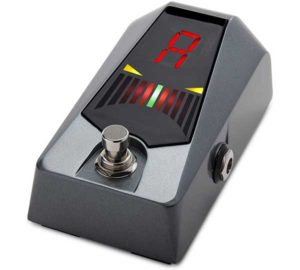 | Tuner | $80 | Read Full Review Below |
| 4. Ibanez BigMini (Best Tuner Under $50) | 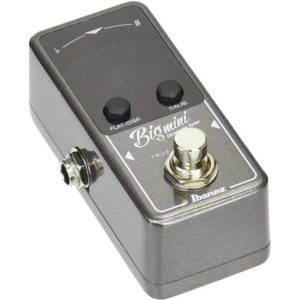 | Tuner | $50 | Read Full Review Below |
| 5. Boss TU-3 | 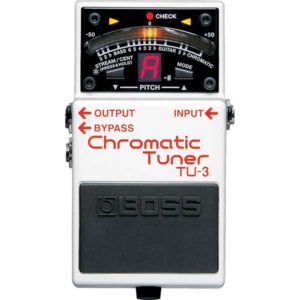 | Tuner | $100 | Read Full Review Below |
| 6. Peterson Strobo Stomp HD | 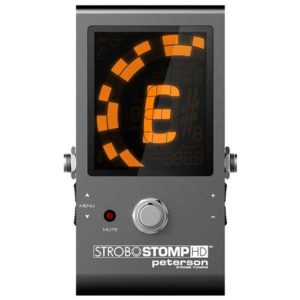 | Tuner | $135 | Read Full Review Below |
| 7. Darkglass Microtubes B7K Ultra V2 Bass Preamp (Best Overall Preamp) | 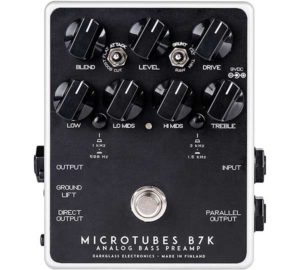 | Preamp | $430 | Read Full Review Below |
| 8. MXR M81 Bass Preamp (Best Value Preamp) | 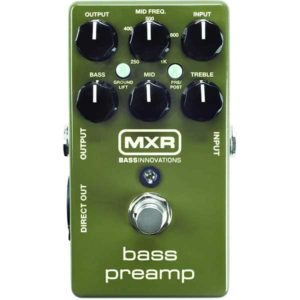 | Preamp | $170 | Read Full Review Below |
| 9. Aguilar Tone Hammer Preamp/Direct Box (Best Preamp Under $300 ) | 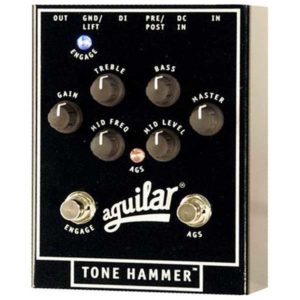 | Preamp / Direct box | $260 | Read Full Review Below |
| 10. Tech 21 SansAmp Bass Driver DI V2 (Best Preamp Under $250) | 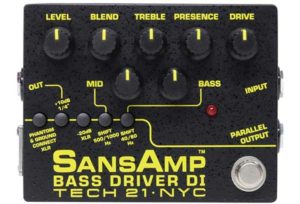 | Preamp | $210 | Read Full Review Below |
| 11. Ampeg SCR-DI - Bass Preamp with Scrambler Overdrive | 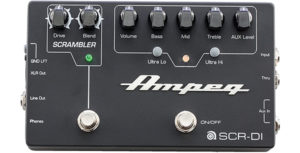 | Preamp | $250 | Read Full Review Below |
| 12. EBS MicroBass 3 2-channel Preamp | 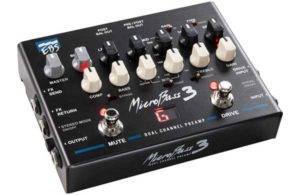 | Preamp | $500 | Read Full Review Below |
| 13. MXR M87 Bass Compressor (Best Overall Compressors) | 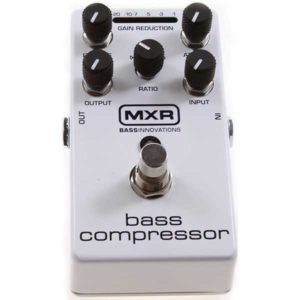 | Compressor | $190 | Read Full Review Below |
| 14. MXR Dyna Comp Bass (Best Value Compressors) | 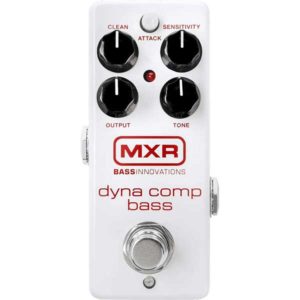 | Compressor | $150 | Read Full Review Below |
| 15. Aguilar TLC Bass Compressor (Best Compressor Under $300) | 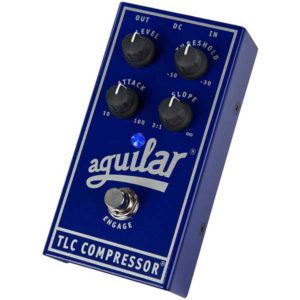 | Compressor | $225 | Read Full Review Below |
| 16. Keeley Bassist Limiting Amplifier (Best Compressor Under $200) | 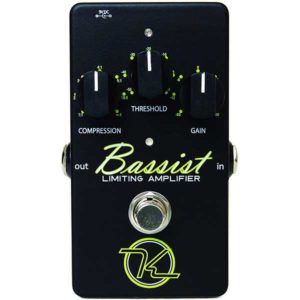 | Compressor | $200 | Read Full Review Below |
| 17. Boss BC-1X Bass Compressor | 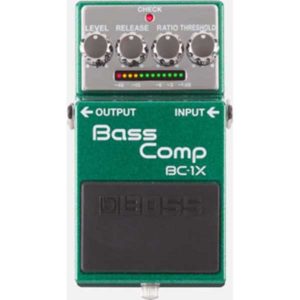 | Compressor | $200 | Read Full Review Below |
| 18. Darkglass Microtubes B7K Ultra V2 Bass Overdrive/Distorion (Best Overall Distortion) |  | Overdrive/Distortion | $430 | Read Full Review Below |
| 19. Behringer Bass Overdrive BOD400 (Best Value Overdrive) | 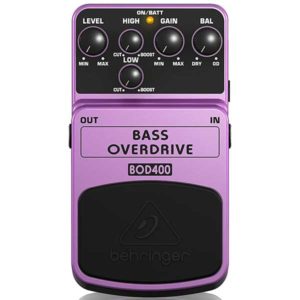 | Overdrive | $25 | Read Full Review Below |
| 20. Aguilar AGRO Bass Overdrive (Best Overdrive Under $200) | 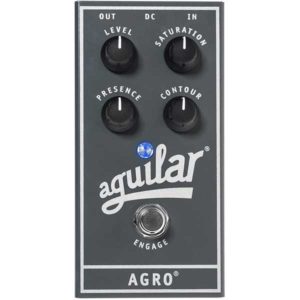 | Overdrive | $200 | Read Full Review Below |
| 21. Electro-Harmonix XO Bass Blogger Distortion (Best Value Distortion) | 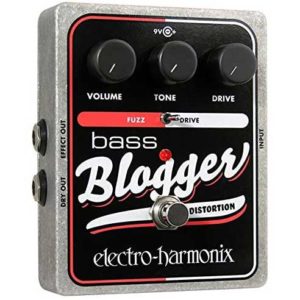 | Fuzz / Overdrive | $75 | Read Full Review Below |
| 22. MXR M85 Bass Distortion (Best Distortion Under $200) | 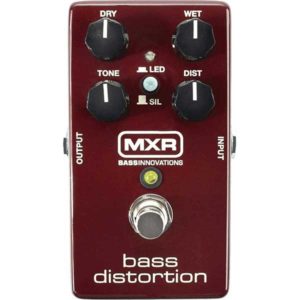 | Distortion | $140 | Read Full Review Below |
| 23. MXR M89 Bass Overdrive | 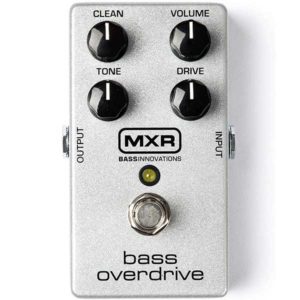 | Overdrive | $130 | Read Full Review Below |
| 24. MXR M280 Vintage Bass Octave (Best Overal Octave) | 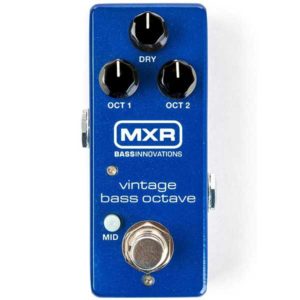 | Octave | $160 | Read Full Review Below |
| 25. MXR M288 Bass Octave Deluxe | 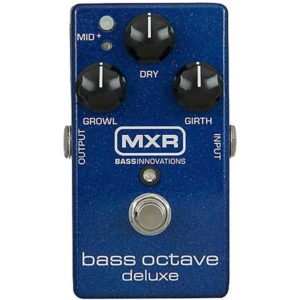 | Octave | $150 | Read Full Review Below |
| 26. MXR M82 Bass Envelope Filter (Best Overall Envelope Filter) | 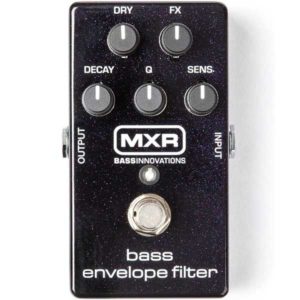 | Envelope Filter | $150 | Read Full Review Below |
| 27. Electro-Harmonix Nano Bassballs Envelope Filter (Best Value Envelope Filter) | 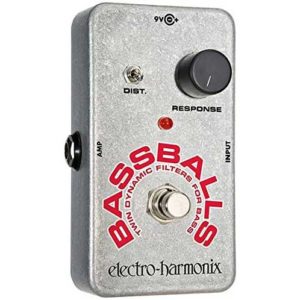 | Envelope Filter | $75 | Read Full Review Below |
| 28. Aguilar Chorusaurus (Best Overall Chorus) | 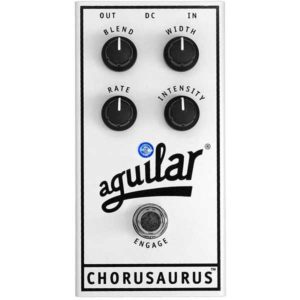 | Chorus | $225 | Read Full Review Below |
| 29. Electro-Harmonix Bass Clone (Best Value Chorus) | 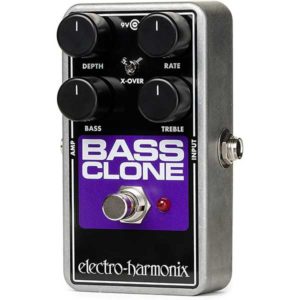 | Chorus | $70 | Read Full Review Below |
| 30. MXR M83 Bass Chorus Deluxe | 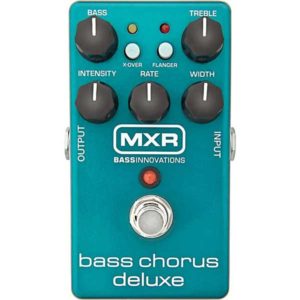 | Chorus | $170 | Read Full Review Below |
Here Are the Best Bass Pedals (All Types)
Now we’ll review our favorite bass pedals in each category.
Best Bass Tuner Pedals
1. TC Electronic Polytune 3 (Best Overall)
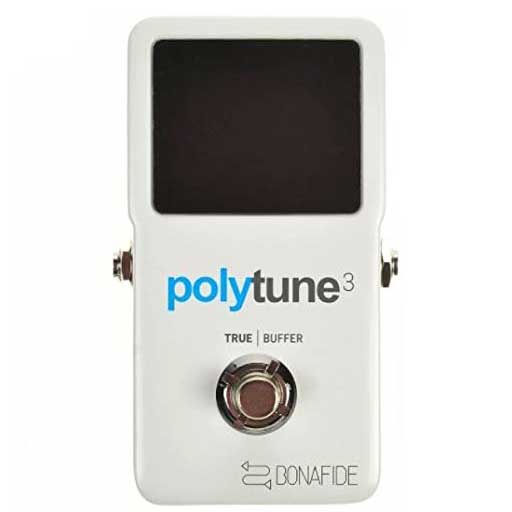
Estimated Price: $100
Pedal Type: Tuner
My Review: There are many tuners out there, but this one is the TC Electronic Polytune 3! When you see a touring musician pedalboard, chances are the Polytune is first in line. Danish pedal maker, TC Electronic has been putting out some mighty fine pedals in the last decade and the Polytune line is their uncontested bestseller. The Polytune has revolutionized the way we tune our guitars back in 2010 when it first arrived, with its solid design, compact form factor, bright display, and of course as the name suggests the polyphonic mode which lets you strum all the strings on your guitar at once, then you tune and then you rock. But the Polytune 3 is even better, it switches automatically between the polyphonic and monophonic modes based on how many strings you play. If you are looking for tuning accuracy then the strobe mode is the one for you, with a +/- 0.02 cent accuracy, while the chromatic mode lets you tune within +/-0.5 cent. They’ve added the Bonafide Buffer circuitry which preserves your signal through long cables and convoluted pedalboards, and you can switch it to True Bypass if you so desire. It even has an ambient light detector that adjusts the super bright 109 LED display for perfect readability in any lighting conditions. There is also a mini version of the Polytune 3 (which is already small among pedals) it trades the Bonafide Buffer circuit for an even smaller form factor.
All in all, if you are looking to buy a tuner, you’ll be hard-pressed to find a better one.
Key Specifications:
- Polyphonic / Strobe Tuner pedal
- Chromatic tuning mode with 0.5 percent accuracy
- Strobe tuning mode witch 0.02 percent accuracy
- Switchable true bypass / Bonafide buffered bypass
- 109 LED display that automatically adjusts the display brightness to lighting conditions
- Switches automatically between polyphonic and monophonic modes
- Footswitchable on/off/mute
- Power consumption: 45mA

2. Behringer TU300 Chromatic Tuner Pedal (Best Cheap)
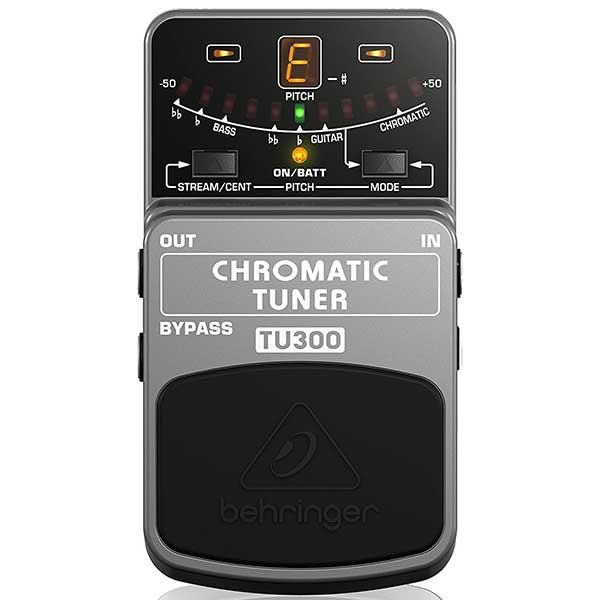
Estimated Price: $30
Pedal Type: Tuner
My Review: If you’re out looking for an affordable tuner pedal with some cool features, you will have some trouble beating the Behringer TU300 outside of the used market. Behringer has a very comprehensive budget pedal lineup and this is one of them. It’s made from the standard Behringer hard plastic enclosure and it offers 4 tuning modes for bass: regular – the standard E tuning, flat – this tunes your bass a half step down, double flat – this will tune your bass a whole step down from standard and chromatic mode which is the only one you should care about. The TU300 is slightly less accurate than other flagship tuners but it will tune your bass or guitar nicely. You really can’t beat it for the money when buying new. Overall this is one of the best cheap tuner pedals for bass.
Key Specifications:
- 7 tuning modes: Chromatic, 3 for bass, 3 for guitar
- 11 LED tuning display
- Accuracy is about +/-1.5 percent
- Outputs: OUT – this mutes your signal when you are tuning and BYPASS – this lets your signal through even while tuning

3. Korg Pitchblack Advance (Best Value)
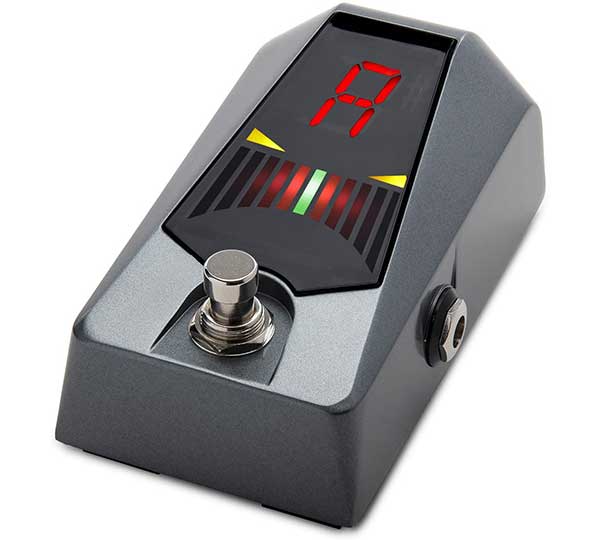
Estimated Price: $80
Pedal Type: Tuner
My Review: The Korg Pitchblack is a standard to which all tuners must compare. With its tank-like construction, big and bright LED display, True bypass, and great tuning accuracy, this little chromatic tuner is really, really hard to beat and it has been for a long time. It offers 4 tuning modes Regular, Strobe, Half-Strobe and Mirror, they all work as expected. One distinguishing feature of the Korg Pitchblack is that it has a 9V DC out from which you can power another pedal with a maximum draw of 200mA, this is enough for most stompboxes and is very useful in relieving clutter on your pedalboard. The accuracy is very good at +/- 0.1 cents. There’s also a mini version of the Pitchblack Advance available. All in all, this is a great tuner.
Key Specifications:
- Tank-like build
- Chromatic tuner with 4 display modes: Regular, Strobe, Half-Strobe and Mirror
- 1 percent accuracy
- True bypass
- 9V DC out up to 200mA
- Power consumption 20mA

Popular Related Article: Top 11 Short Scale Bass Guitars
4. Ibanez BigMini (Best Under $50)
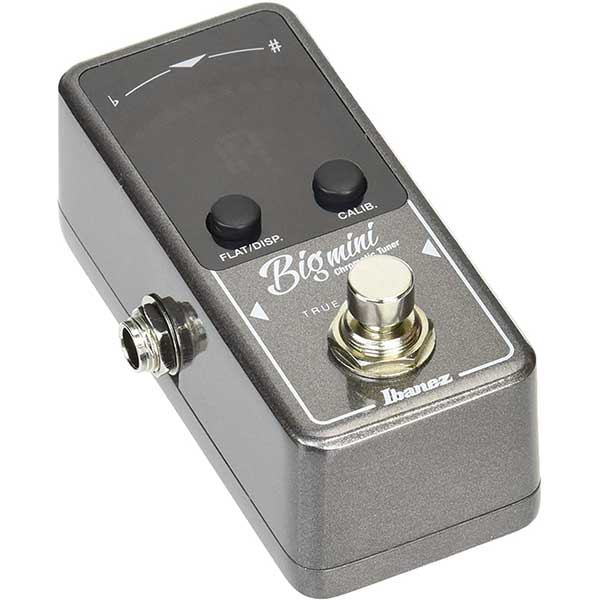
Estimated Price: $50
Pedal Type: Tuner
My Review: Ibanez is a long time manufacturer of great quality stompboxes and some legendary ones as well, the Big Mini tuner pedal could fit in somewhere between these two categories. As the name suggests it’s a super small tuner pedal with a solid build quality, a great price point, and has good features. It offers a true bypass circuit, strobe, and needle tuning modes with +/-1 percent accuracy and a bright display. You really can’t go wrong with this one.
Key Specifications:
- Super small sized chromatic tuner
- Needle and strobe display modes
- +/-1 percent accuracy
- True bypass
- Power consumption 9V 14mA

5. Boss TU-3
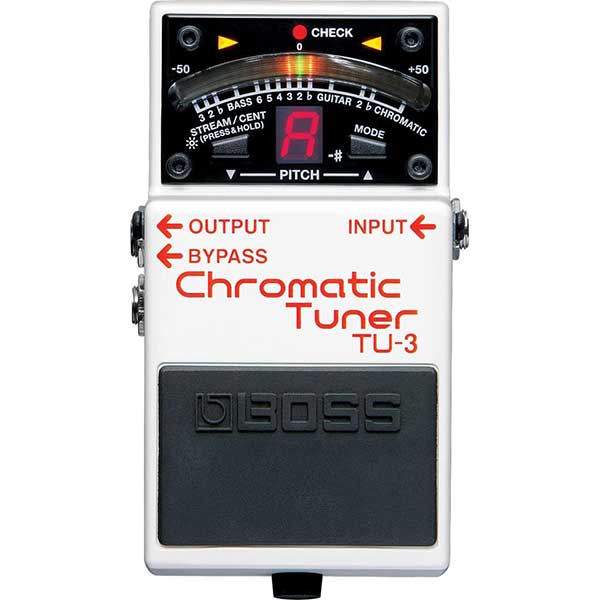
Estimated Price: $100
Pedal Type: Tuner
My Review: This is one of the greats from BOSS, probably the biggest pedal manufacturer out there. The TU-3 is a solid chromatic tuner with a better display (high brightness mode), being easier to read in bright daylight than its predecessor, and tons of display and tuning options. You can also power a few pedals from it thanks to its 9V DC out. They also make a mini version of the TU-3. It’s an improvement of a classic, a great tuner without a doubt.
Specs:
- 21 segment LED with brightness control
- Supports 6-String Basses
- Accuracy +/-1 cent
- Can power up to 7 pedals from the DC out
- Reference pitch: A4 436Hz-445Hz

Popular Related Article: Recommended Beginner Bass Guitars
6. Peterson StroboStomp HD
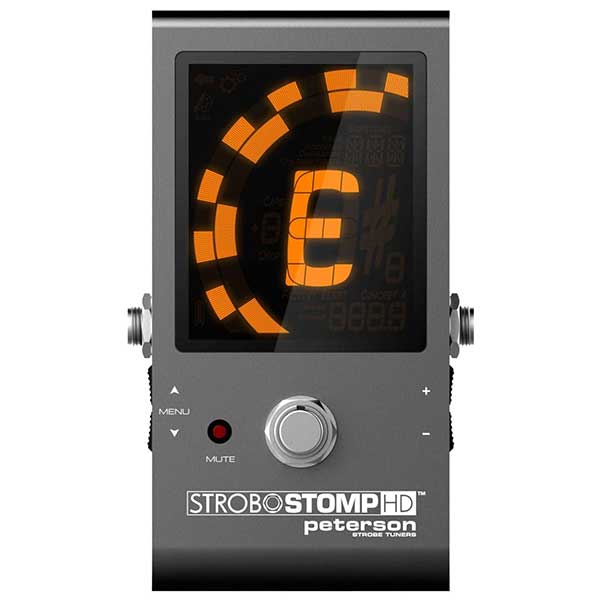
Estimated Price: $135
Pedal Type: Tuner
My Review: The Peterson StroboStomp HD offers outstanding tuning accuracy coming in at 0.1 percent and a ridiculously huge LCD display with variable color LED backlight, true bypass, buffered output, and buffered monitor modes, it supports 6 string basses, multiple tuning presets – and it even orders them according to your most commonly used ones. But all this tech and versatility comes at a price. If you want elite performance in a tuning pedal then this is the one for you.
Specs:
- High definition LCD screen with variable LED backlight
- Accuracy 1 cents
- True Bypass
- Supports 6-string basses
- Over 100 Sweetened tunings

Best Bass Preamp Pedals
7. Darkglass Microtubes B7K Ultra V2 Bass Preamp (Best Overall)
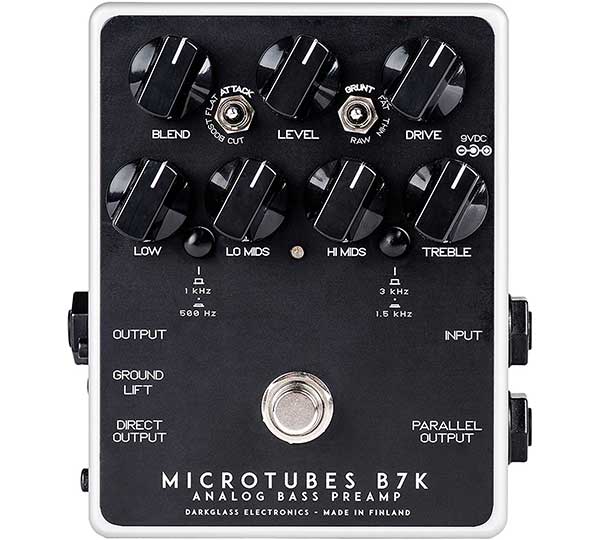
Estimated Price: $430
Pedal Type: Preamp
My Review: As a new player on the bass pedal market you have to bring something new and exciting to the bass table, and finish Darkglass Electronics has brought us exactly that. The Darkglass Microtubes B7K Ultra V2 brings modern sounds to a mostly stale pedal segment. It pairs a blendable and individually foot-switchable bass distortion section with a powerful and versatile preamp section and the result is very, very fine indeed. From the heaviest of distortions to the cleanest of cleans and everything in between, this little powerhouse has got you covered. The preamp section has a versatile EQ offering, Bass, Low Mid, High Mid, and Treble knobs, both the mids having selectable three-way center frequency dip switches. The distortion section sports a Drive (sets the saturation of the overdriven signal), Level (sets the volume of the overdriven signal) and Blend( sets the mix between the dry and the overdriven signal) knobs and 2 dip switches marked Attack and Grunt, determining how the top and bottom end respond to the distorted signal. The Master knob controls the overall output volume. And this being the second version of the B7K ultra, they added a headphone out and a cabinet simulation to the DI out. As a bonus feature, you can load different cabinet simulations from your computer through the free Darkglass suite software, available for download on the Darkglass website. Overall, this is easily one of the best bass pedals out there.
Key Specifications:
- Analog overdrive with digital cabinet simulation
- +/-12dB Bass@ 100Hz, +/-12dB Low Mids switchable@ 250Hz, 500Hz and 1kHz, +/-12dB High Mids switchable@ 750Hz, 1.5KHz and 3kHz, +/-12dB Treble@5kHz
- Balanced XLR output
- 3.5mm Headphone in
- 3.5mm aux stereo input
- Ground lift switch for eliminating ground loops in the balanced DI outPower consumption 120mA from 9V DC adapter only (does not accept 9V batteries)

8. MXR M81 Bass Preamp (Best Value)
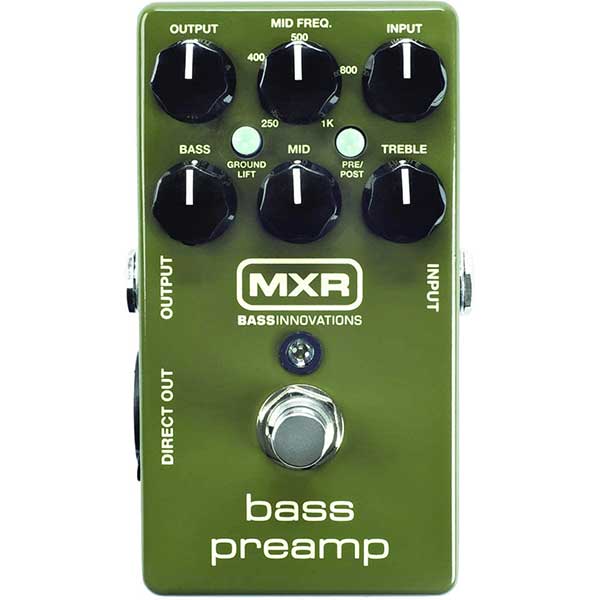
Estimated Price: $170
Pedal Type: Preamp
My Review: MXR is well known for making high quality pedals and the M81 Bass preamp is no exception to the rule. This stompbox really packs a punch for the size and the price. Housed in the standard MXR enclosure, it features separate input and output level knobs, a versatile 3-band EQ section with a 5-way selectable center frequency for the mids at 250Hz, 400Hz, 500Hz, 800Hz, and 1kH. It has a studio quality balanced XLR DI out with a ground lift switch and a pre/post EQ switch giving you the option to select if your DI signal to the console or PA is affected by the EQ settings or not. You can also choose to disable the DI out or choose between buffered bypass and true bypass via internal dip switches. If you are on a budget and looking for a high quality preamp then this is the pedal you want to take a closer look at.
Key Specifications:
- Small form factor
- Separate input and output level controls
- 3-band EQ with sweepable midrange
- Selectable buffered bypass or true bypass and DI on/off via internal dip switches
- Studio quality DI out

9. Aguilar Tone Hammer Preamp/Direct Box (Best Under $300)
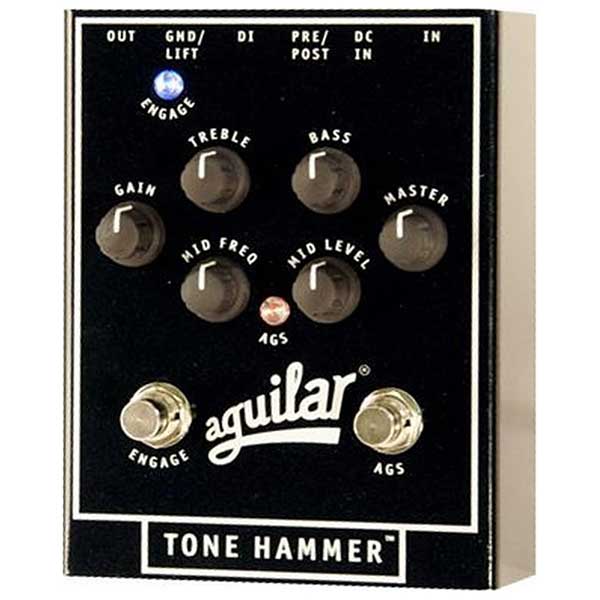
Estimated Price: $260
Pedal Type: Preamp
My Review: Aguilar is one of the greats in the bass world offering pickups, preamps, amps, cabinets, and effects to bass pros all over. But the Tonehammer preamp is special, so special in fact that it sparked their very successful Tonehammer Amp lineup. In essence, it’s a great sounding
DI box, a preamp with a powerful 3 band EQ featuring a fully sweepable midrange and an added overdrive section which they call AGS (Adaptive Gain Shaping). Both the preamp and AGS have their own footswitches but the preamp needs to be engaged for the AGS to work. A bonus is the internal 18V operation which gives you headroom to spare. It sports a balanced XLR DI out with pre/post EQ and ground lift switches in addition to the standard ¼” jack input and output. You have three options to power it: with two 9V block batteries, a PSU, or by Phantom power which is really nice. From great vintage sounds to modern, heavily overdriven basslines, the Aguilar Tonehammer really is what its name suggests.
Key Specifications:
- Heavy duty steel construction
- 18V operation for increased headroom
- 3-band EQ with fully sweepable midrange (Bass +/- 18dB @ 40Hz, MId +/-17dB @ 180Hz-1kHz, Treble +/-18dB@ 4kHz)
- Ground lift Switch
- Pre/Post DI switch
Popular Related Articles: 17 Best Bass Amps
10. Tech 21 SansAmp Bass Driver DI V2 (Best Under $250)
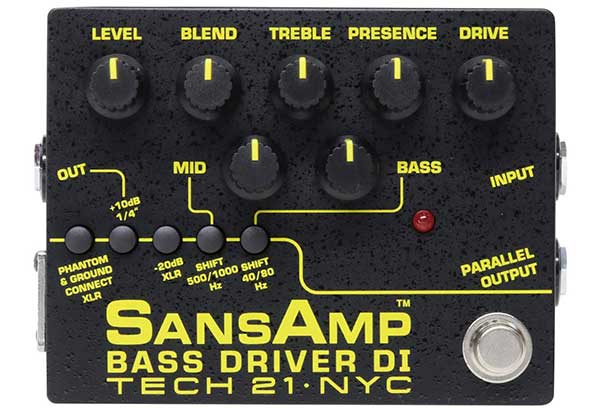
Estimated Price: $210
Pedal Type: Preamp
My Review: The SansAmp Bass Driver DI is a classic that has been in production for ages, and with good reason – it is a reference pedal among bass preamps. It probably is the best selling preamp/DI for bass guitar. And the V2 is even better than the original. One of the drawbacks of the original was a lack of mid control which Tech 21 has corrected by making it a 3-band EQ with +/-12 dB cut/boost instead of the old 2-band EQ with only bass and treble controls. They also added selectable center frequencies for the mids(500Hz or 1000Hz) and bass(40Hz or 80Hz) making this preamp better suited for extended range basses.
The footswitch will only activate the SansAmp Tube Amplifier Emulation circuitry, it is not a bypass for the pedal. Besides the EQ, on the faceplate you will find the control knobs for Drive – adjusting the overall gain structure, Presence – controlling the amount of upper harmonic content, Level – sets the levels for standard ¼” and XLR out and Blend – Mixing your dry signal with the Tube Emulation circuitry. Balancing levels on the bass driver can sometimes feel a little cumbersome as the Drive, Blend, and Level knobs all influence each other, but it’s nothing you can’t get used to after playing with it for a few minutes.
It offers 3 output solutions: a ¼” out with +10dB selectable through a switch, a ¼” parallel out from which you’ll get a completely dry signal, and the balanced XLR out with selectable -20dB also through the use of a switch on the faceplate.
The Bass Driver DI is a workhorse for the bass player masses, you’ll get classic tube sounds, a great DI, and it won’t break the bank. If you’re looking for the best bass pedal, this should be a top contender.
Key Specifications:
- Always on preamp
- SansAmp Tube Amplifier Emulation circuitry on/off through the footswitch
- 3-band EQ with selectable center frequencies for bass(+/-12dB @ 40Hz or 80Hz) and mids(+/-12db @ 500Hz or 1000Hz)
- 3 output options: effected ¼” out, effected balanced XLR out and ¼’’ parallel out for your dry signal only
- +10dB switch for the ¼” effected output
- -20dB switch for the balanced XLR output
- Ground lift switch
- Power supply via 9V battery, PSU or phantom power

11. Ampeg SCR-DI – Bass Preamp with Scrambler Overdrive
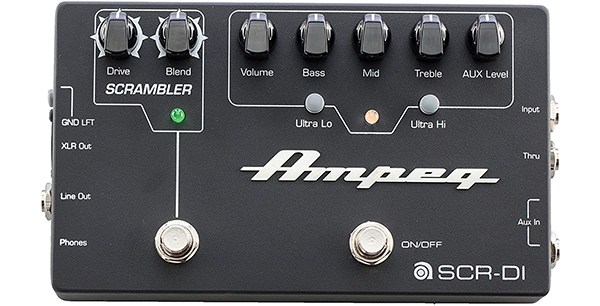
Estimated Price: $250
Pedal Type: Preamp
My Review: If you’ve ever dreamed of having an Ampeg full stack in your gigbag, then maybe the Ampeg SCR-DI is the pedal for you. The pedal is divided into 2 sections, the preamp section and the overdrive/distortion section also called the scrambler. The preamp section is minimalistic in its layout with a volume knob, 3-band parametric EQ, and Aux Level – setting the volume for the two auxiliary inputs and 2 switches for the Ultra HI and Ultra LO circuits. The scrambler has 2 knobs: Drive which controls the amount of overdrive and Blend which blends the former with the signal coming from the preamp section. It has an on/off footswitch for the preamp and an on/off footswitch for the scrambler. But in classic Ampeg fashion, from such minimalism comes greatness. There are 3 inputs: the standard ¼” instrument in and two Aux inputs, one in 3.5mm, the other in ¼” and there are 4 outputs: a dry ¼” out, a ¼” affected out, a balanced XLR DI out plus a 3.5mm Headphone out.
This means that you can even use it as a standalone practice amp, besides being an Ampeg full stack simulator with a great DI and great sounds.
Key Specifications:
- 3-band parametric EQ
- Ultra HI and Ultra LO circuits
- DI out with ground lift switch
- 3 inputs: ¼” instrument in, ¼” aux in, 3.5mm aux in
- 4 outputs: ¼” dry through, ¼” affected out, balanced XLR out, 3.5mm headphone out

12. EBS MicroBass 3 2-Channel Preamp
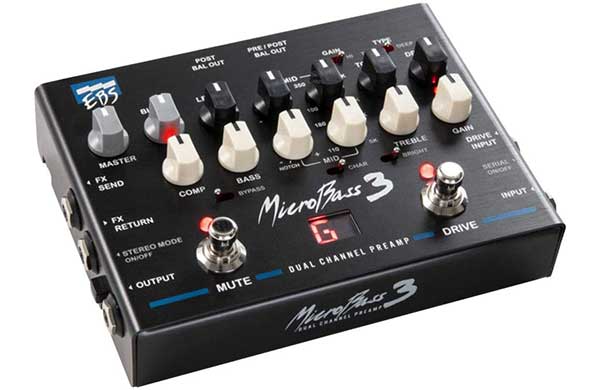
Estimated Price: $500
Pedal Type: Preamp
My Review: If there ever was a Swiss army knife of bass preamps, then the Swedish manufacturer EBS has built it with the Micro bass 3. This is a bass preamp with two individual channels for clean and distorted sounds, each with its own EQ section which can run in parallel or in series. Microswitches offer a multitude of tonal variation and response options. It features extensive and flexible routing options catering to any situation you could envision. There’s also a one knob compressor and a tuner onboard. The clean section has a 3 band EQ with semi-parametric mids, while the drive channel retains the semi-parametric mids but replaces the bass and treble with a simple Tone control. The Blend knob mixes the clean and drive channels allowing for creative tone sculpting. It also boasts a serial effects loop with a stereo return. All this premium functionality comes at a premium price though, so if you’re looking for the “do it all” preamp give this one a try.
Key Specifications:
- 2 channel Bass preamp
- 3-band EQ with semi-parametric mids
- Onboard one knob compressor and a Tuner (activated when the global mute switch is engaged)
- 4 inputs: ¼” instrument in, ¼” drive input, 3.5mm aux in, ¼” return
- 5 outputs: ¼” out, balanced XLR post EQ, Balanced XLR pre/post EQ, ¼” send, 3.5mm headphone out
- Power supply: 400mA @9V

Best Bass Compressor Pedals
13. MXR M87 Bass Compressor (Best Overall)
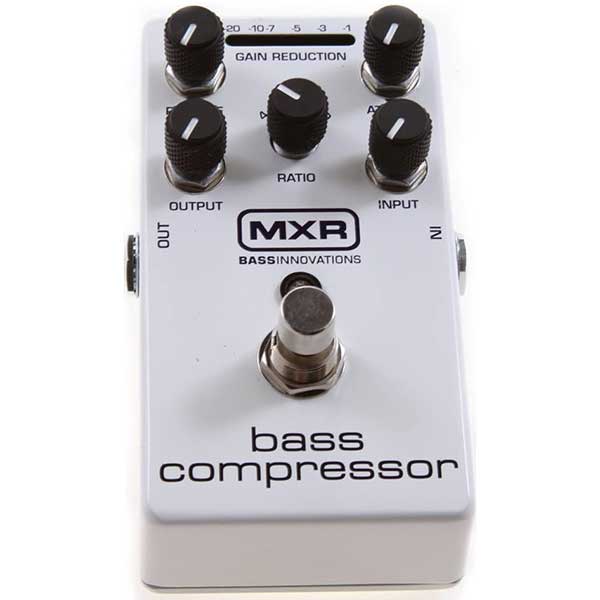
Estimated Price: $190
Pedal Type: Compressor
My Review: MXR has built a studio quality compressor into a standard sized bass pedal that doesn’t color your tone. The M87 Bass compressor gives you access to 5 control knobs to shape your sound as you please, Attack, Release, compression Ratio (selectable between 4:1,8:1,12:1 and 20:1), Input and Output level control. The Constant Headroom Technology(CHT) MXR has built into this little compressor ensures that you have plenty of headroom for any of your dynamic needs until you reach the compression threshold and the 10 LED display lights up showing you by how much your signal is attenuated when the compressor starts working. It features a true bypass, comes with a small footprint, and is totally transparent. You just can’t ask for more.
Key Specifications:
- Input level,Output level, Attack, Release and Ratio controls
- MXR Constant Headroom Technology (CHT)
- True bypass
- ¼” in, ¼” out
- Power supply: your choice of 9V block battery or PSU

14. MXR Dyna Comp Bass (Best Value)
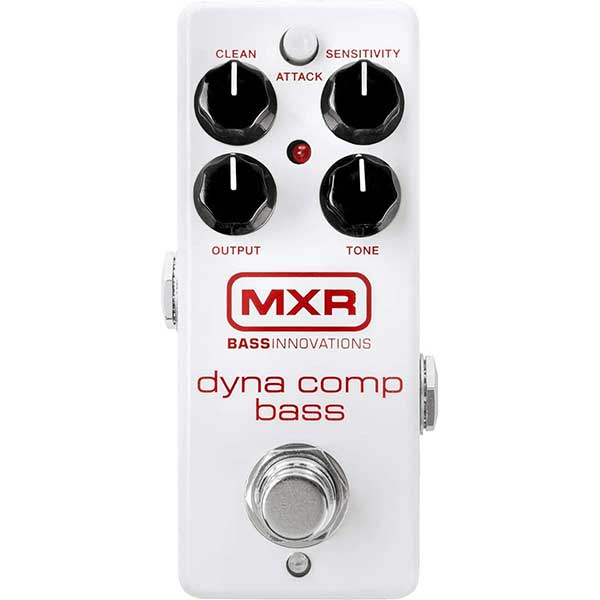
Estimated Price: $150
Pedal Type: Compressor
My Review: If you feel you are in need of a simple, easy to use compressor or your pedalboard starts to get cramped or if you are on a budget but you don’t want to compromise on sound quality – the MXR Dyna Comp Bass may tick all these boxes for you. It gives you 4 knobs to fiddle with: the Output knob adjusts the volume of the compressed signal, Clean blends your wet and dry signals together, Tone boosts or cuts the midrange at 1kHz and Sensitivity lets you adjust sustain (probably a combination of compression ratio and release). The Attack switch lets you choose between shorter and longer attack times. The Dyna Comp Bass is built around the iconic CA3080 circuit, ensuring heaps of dynamic range, low noise, and transparency. It comes in a very small form factor so you won’t have any issues adding it to your board. This is a great little compressor!
Key Specifications:
- Analog bass compressor
- Controls for Clean – blends the wet and dry signals, Tone – midrange boost/cut@1kHz, Sensitivity adjusts sustain, Output adjusts the output volume
- Attack switch toggles between fast and slow attack times
- ¼” in, ¼”out
- Power supply: 11mA@9V PSU only

15. Aguilar TLC Bass Compressor (Best Under $300)
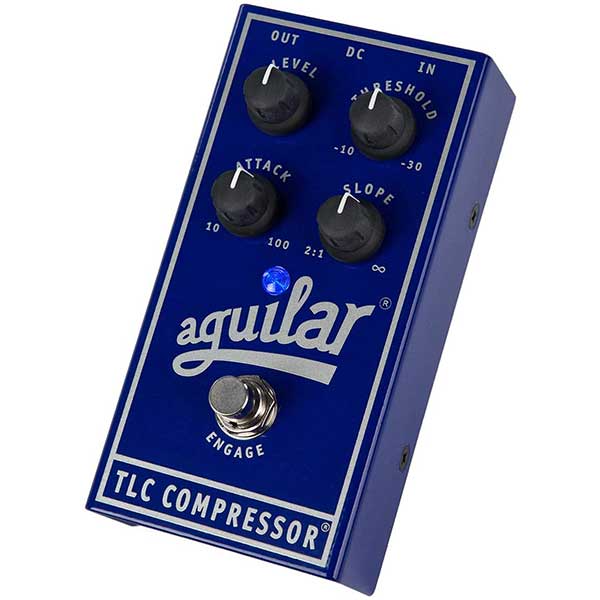
Estimated Price: $225
Pedal Type: Compressor
My Review: Aguilar Amplification have outdone themselves with this one. The TLC Bass Compressor is a super clean and transparent pedal offering a fully featured set of controls in a small and rugged package. The layout features 4 knobs catering to all of your compression needs; Level – adjusts the output level of the pedal from -infinity to -3dBu, the Threshold knob varies the point at which the compressor engages from -30dBu to -10dBu, Attack sets how fast the compressor will respond when reaching the threshold from 10ms to 100ms and Slope which lets you dial in the compression ratio from 2:1 to infinity. These ranges are mostly adequate except for the Attack which could benefit from a longer response time in order to increase the versatility of the pedal. The TLC features a true bypass which is always nice and also comes equipped with something called Trans Linear Control (hence TLC) that Aguilar Amplification claims will enhance your dynamic response in a positive way.
If you are looking to get a quiet, transparent, well designed compressor, with control over most of your compression parameters, give The TLC Bass compressor an ear or two.
Key Specifications:
- Controls knobs for Level (output), Threshold, Attack and Slope (Ratio)
- TLC circuit (Trans Linear Control)
- True bypass
- ¼” instrument in, ¼” out
- Power supply: PSU or 9V block battery

16. Keeley Bassist Limiting Amplifier (Best Under $200)
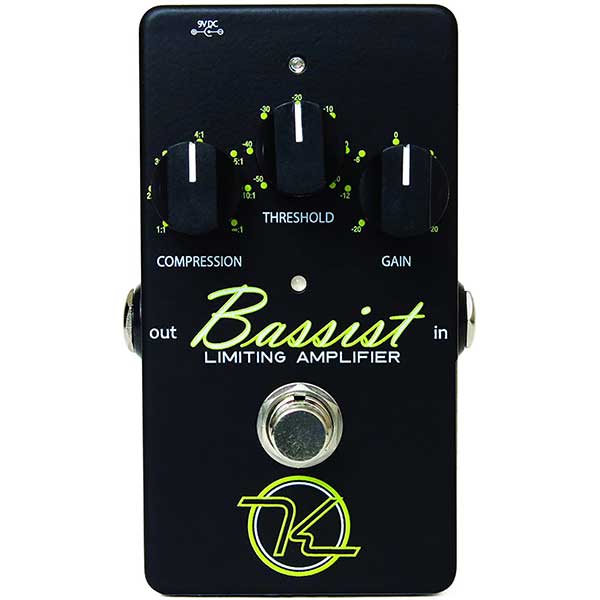
Estimated Price: $200
Pedal Type: Compressor
My Review: Keeley Electronics know their compressors, building high quality compression pedals tailored for guitar players for many years. But the Bassist Limiting Amplifier is designed specifically for us bass players. It’s built around the high fidelity THAT Corp. 4320 chip bringing studio-like performance to an extremely pedalboard-friendly format. It features a very low noise floor (it’s very quiet while in use) and high bandwidth of over 20kH ensuring no part of your sound gets lost when you turn it on. There are only 3 knobs to experiment with, Compression (adjusting the compression ratio from 1:1 up to infinity:1), Threshold – setting the point at which the compressor starts compressing away and Gain determining the output volume of the pedal. Attack and Release times are set automatically and continuously depending on the way you play. It can also be used as both a limiter and a transparent clean boost pedal.
Key Specifications:
- Control knobs for Compression ratio(1:1 to infinity:1), Threshold, Gain (setting the output level)
- Automatically adjusts Attack and Release depending on the way you play
- ¼” instrument in, ¼” out
- High bandwidth of above 20kHz
- Output Voltage Gain +30dB Boost
- Low noise floor : -95dBV
- Power supply: 50mA@9V from a 9V battery or PSU

17. Boss BC-1X Bass Compressor
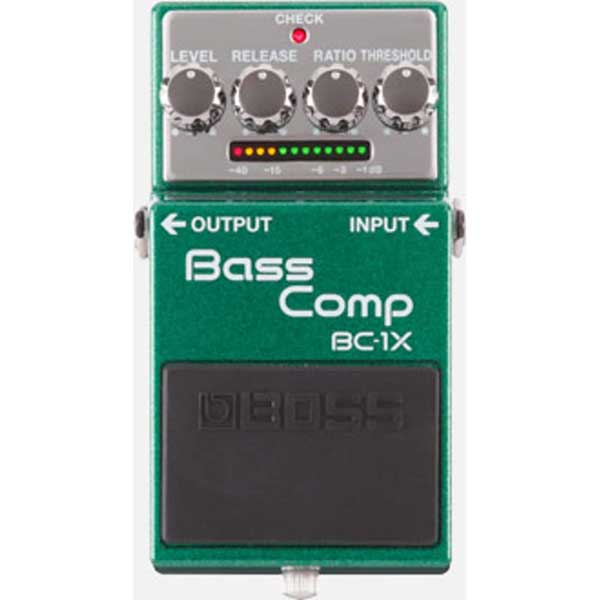
Estimated Price: $200
Pedal Type: Compressor
My Review: The Boss BC-1X is a compression beast, packed to the brim with intelligent pro-grade circuitry. It features multiband compression that will adapt to your playing style, never letting your sound turn to mush. The simple 4 knob interface (Threshold, Ratio, Release, Level) hides a multitude of parameters that work in unison to shape the sound you want without much effort.
The Bc-1X just sounds good whatever you do with it. The internal 18V circuitry ensures that you never run out of headroom. It also displays the amount of compression applied at all times through the use of a 16 segment gain reduction indicator. The verdict: you literally can’t go wrong with the BC-1X
Key Specifications:
- 4 knob control interface (Threshold, Ratio, Release, Level)
- 16 segment gain reduction indicator
- ¼” instrument in, ¼” out
- Internal 18V circuitry
- Power supply: 90mA@9V with a PSU or 9V block battery

Best Bass Overdrive and Distortion Pedals
18. Darkglass Microtubes B7K Ultra V2 Bass Overdrive/Distortion (Best Overall)

Estimated Price: $430
Pedal Type: Overdrive/Distortion
My Review: The Darkglass Microtubes B7K Ultra V2 really takes the cake, as a powerful overdrive/ distortion, and preamp. With this pedal you have the option of using it as a preamp, masterfully sculpting your bass tone. But then, at the touch of the distortion foot switch you get blown away by its wide range of overdrive AND distorted sounds which you can effortlessly blend with your clean signal and reshape through the use of the Grunt and Attack dip switches. These shape how the top and bottom end saturate with overdrive or distortion.
The preamp section features a 4-band EQ, the low and high mids each have 3 selectable center frequencies and is toggled with the bypass footswitch. On top of the preamp sits the overdrive section, engaged with a touch of the distortion footswitch, comprised of Drive (setting the amount of the distortion effect), Level (controlling the volume of the effect), Blend (determining the mix between your wet and dry signal) and Master(for the overall volume) knobs.
In fact, it’s so good it takes top spots in both the preamp and overdrive/distortion segments.
Key Specifications:
- Analog overdrive with digital cabinet simulation
- +/-12dB Bass@ 100Hz, +/-12dB Low Mids switchable@ 250Hz, 500Hz and 1kHz, +/-12dB High Mids switchable@ 750Hz, 1.5KHz and 3kHz, +/-12dB Treble@5kHz
- Balanced XLR out
- 3.5mm Headphone in
- 3.5mm aux stereo input
- Ground lift switch for eliminating ground loops in the balanced DI out
- Power consumption 120mA from 9V DC adapter only (does not accept 9V batteries)

19. Behringer Bass Overdrive BOD400 (Best Value Overdrive)
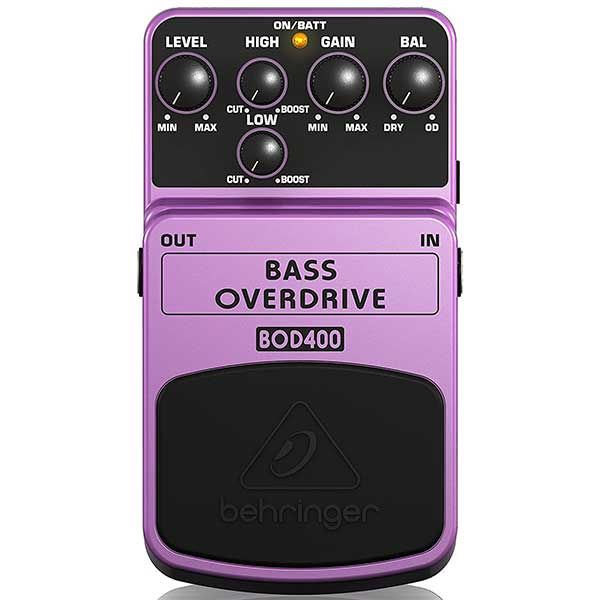
Estimated Price: $25
Pedal Type: Overdrive
My Review: This is a purple $25 pedal housed in a hard plastic enclosure made for the bass player on a budget. But in this case, 25$ gets you a lot more sound than you might expect. It’s got a 2-band active EQ with boost/cut function (bass and treble), a Gain knob controlling the amount of overdrive, a Level knob for the output volume, and a Blend knob to mix your dry and wet signals to your preference. It is largely based on the legendary Boss ODB line of overdrives, and in a blind A/B comparison you would have some difficulty spotting which is which. Great price, great tone, great pedal.
Key Specifications:
- Hard plastic enclosure
- 2-band EQ cut/boost
- Balance, Level and Gain knobs
- ¼” instrument in, ¼” out
- Power supply: 9V block battery or PSU

20. Aguilar AGRO Bass Overdrive (Best Overdrive Under $200)
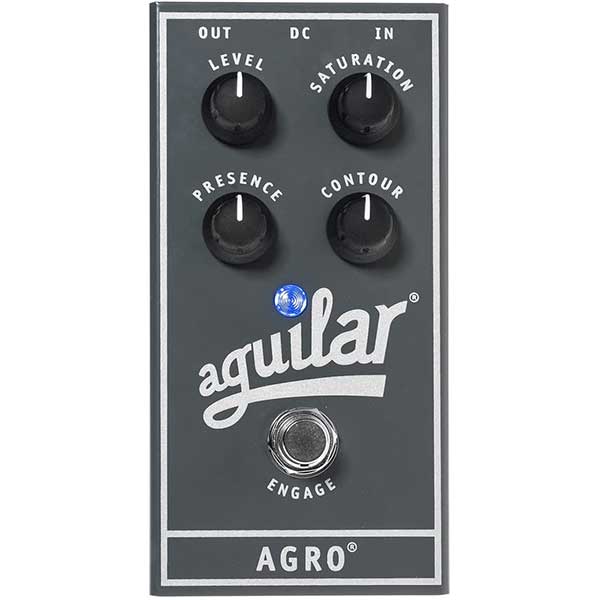
Estimated Price: $200
Pedal Type: Overdrive
My Review: The AGRO is a straightforward overdrive pedal based on the saturation channel of Aguilar’s AG 500 bass head. Whenever you feel like you need a natural, tube-like edge to your bass sound, the AGRO hits the spot. It offers the whole palette of overdrive sounds from subtle to dramatic. It’s simple 4-knob layout makes dialing in the tone you want a breeze. The contour control is a broad spectrum mid scoop centered around 900Hz, Presence is a +6dB/-20dB boost/cut at about 4kHz, Saturation sets the amount of distortion added to you signal and the Level knob lets you adjust the output volume of the pedal. It also has a true bypass circuit.
Key Specifications:
- 4-knob layout with Level, Saturation, Presence and Contour controls
- True bypass
- ¼” instrument in, ¼” out
- Power supply: 9V block battery or PSU

21. Electro-Harmonix XO Bass Blogger Distortion (Best Value Distortion)
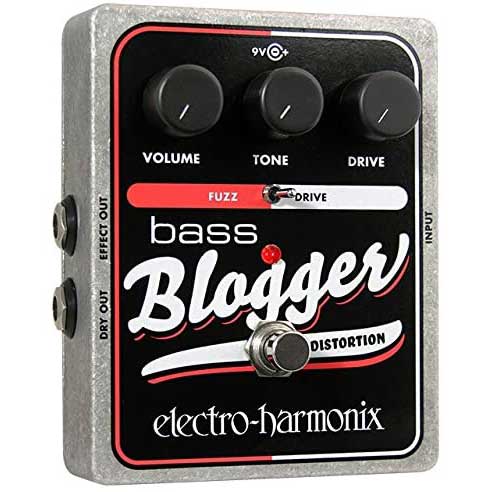
Estimated Price: $75
Pedal Type: Distortion
My Review: This is a great fuzz/overdrive/distortion pedal from legendary pedal maker Electro-Harmonix. It features a simple 3-button layout with a Volume knob that adjusts the output volume of the pedal, a Tone control that adds treble to your tone and a Drive knob that sets the amount of distortion. The fuzz/drive switch toggles between the overdrive and the insane fuzz circuit. There is a ¼” instrument input and two ¼” outputs for your wet and dry signals. The sounds you get out of this tank in pedal form, range from subtle old school low-fi overdriven bass to harmonically saturated madness, at this price you can’t beat it.
Key Specifications:
- Simple and sturdy design in an all metal enclosure
- 3-knob layout with Volume, Tone and Drive knobs
- Fuzz / Drive dip switch
- Separate Dry/Wet ¼” outputs

22. MXR M85 Bass Distortion (Best Distortion Under $200)
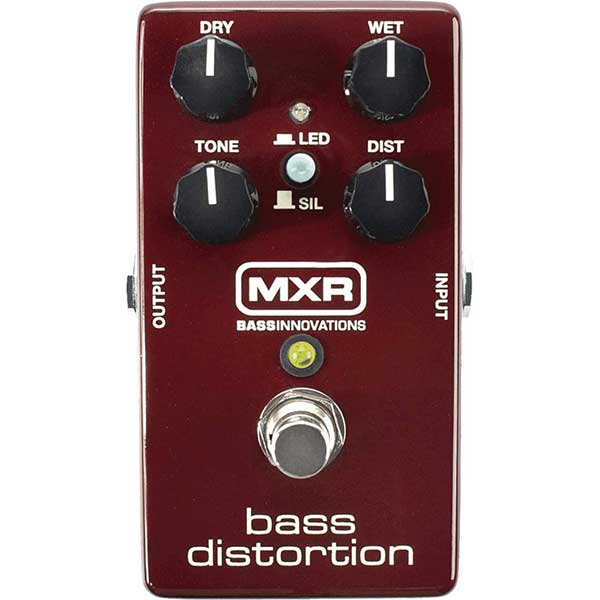
Estimated Price: $140
Pedal Type: Distortion
My Review: The M85 Bass Distortion pedal was born from a collaboration between MXR and Fuzzrocious Pedals founder Ryan Ratajski. They modified an iconic distortion circuit, adapting it for use in a modern bass context. The M85 features two tone generation modes: Silicone Clipping Diodes for an aggressive, compressed distortion and LED clipping for a dynamic tone with increased gain, selectable through the push of a button on the faceplate. There’s an internal trim pot that allows you to set the maximum gain for the LED mode. The distortion itself affects only the high end and leaves your fundamentals intact. The Tone knob is a high frequency roll off, only affecting the distorted signal, the Distortion control sets the amount of distortion in your signal and the separate Dry and Wet controls let you mix your signals at your leisure. There is also a true bypass circuit.
Key Specifications:
- Two distortion modes, silicon diode or LED
- Internal trim pot sets the maximum gain level of the LED mode
- Separate Dry/Wet controls
- ¼” instrument in, ¼” out
- Power supply: 11mA@9V from a 9V block battery or PSU

23. MXR M89 Bass Overdrive

Estimated Price: $130
Pedal Type: Overdrive
My Review: The M89 is a very harmonically rich overdrive pedal that delivers warm, punchy tube-like sounds. It features a simple 4-button layout with Volume( adjusting the output level), Tone (high end roll-off ) and Drive(amount of distortion) controls, and a Clean control that blends your dry signal with your distorted signal. This is a great pedal, worth considering when looking for a natural, overtone rich overdrive.
Key Specifications:
- Analog overdrive pedal
- 4-button layout with Clean, Volume, Tone and Drive controls
- ¼” instrument in, ¼” out
- Power supply: 9V block battery or PSU

Best Bass Octave Pedals
24. MXR M280 Vintage Bass Octave (Best Overall)
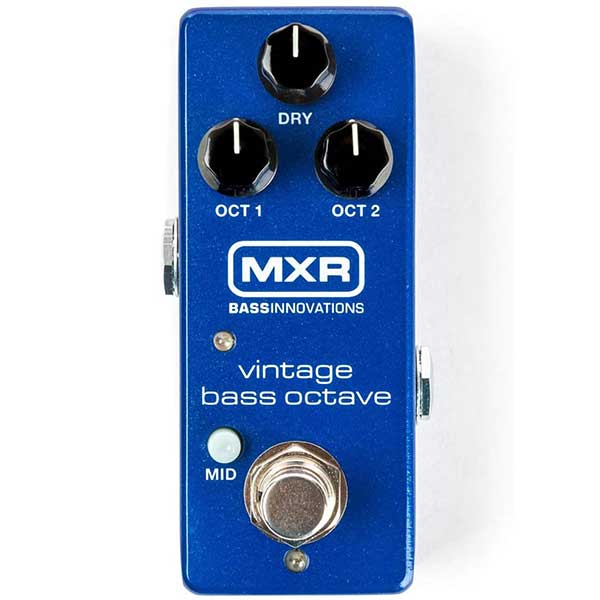
Estimated Price: $160
Pedal Type: Octave
My Review: The M280 Vintage Bass Octave brings warm analog sounds to your table, from chest-thumping dub-bass to wall-shaking growls and all this in the MXR mini housing. It comes equipped with 2 voices, one octave down and two octaves down, which you can blend as you see fit using the OCT1 and OCT2 volume control. With the Dry volume control, you can add your dry signal into the mix creating the perfect combination for any musical occasion. If you need more presence and clarity in your tone, you can activate the Mid switch to boost your mids by 6dB at 800Hz. For an even greater boost of up to 13dB, you can access the internal trim pot under the bottom plate. The M280 features a true bypass and MXR’s Constant Headroom Technology or CHT ensures that you never run out of headroom, this little octaver really packs a punch.
Key Specifications:
- All analog bass octave pedal
- Super small form factor
- 2 octave options, one octave down + two octaves down
- OCT1, OCT2, and Dry Volume controls
- Switch for midrange boost 6dB@800Hz, up to 13dB via internal trim pot
- True bypass circuit
- ¼” instrument in, ¼” out
- Power supply: 9V PSU

25. MXR M288 Bass Octave Deluxe
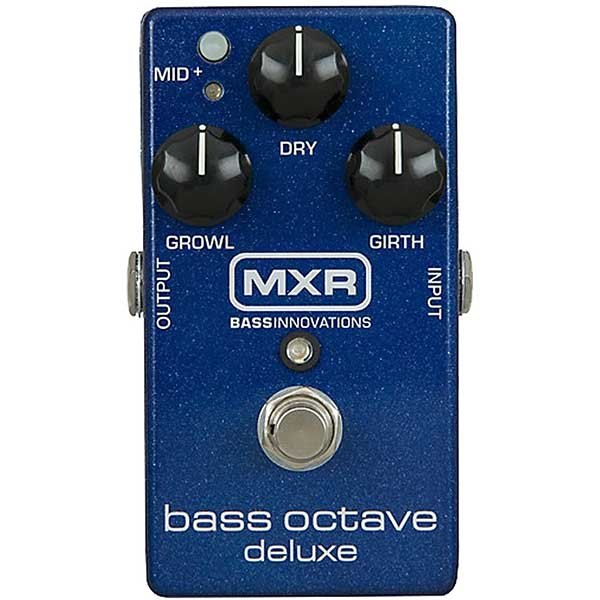
Estimated Price: $150
Pedal Type: Octave
My Review: The M288 Bass octave deluxe is an analog, dual-voice octaver, giving you a wide range of octave down sounds. The Dry volume control lets you add your unaltered signal to the two independent octave voices, which can be blended together with the Growl and Girth controls. The Growl octave-down has a synth-like sound, while the Girth octave-down voice has a less high end with a dub-bass character. Blending these three controls creates a wealth of sub bass goodness. The M288 features a true bypass circuit and MXR’s CHT(Constant Headroom Technology) which internally converts the 9V coming from the PSU to 18V giving loads of headroom and improved tracking. Hit the MID+ switch to add up to +14dB of internally adjustable mids at 400Hz or 850Hz. In my opinion, this is easily one of the best bass guitar pedals out there.
Key Specifications:
- Analog dual-voice octaver pedal
- CTH (Constant Headroom Technology) offers improved headroom and tracking
- Independent volume controls for Dry, Growl and Girth
- Mid+ switch boosts the midrange by up to 14dB@450Hz or 800Hz
- True bypass switch
- Power supply: 9V block battery or PSU

Best Bass Envelope Filter Pedals
26. MXR M82 Bass Envelope Filter (Best Overall)
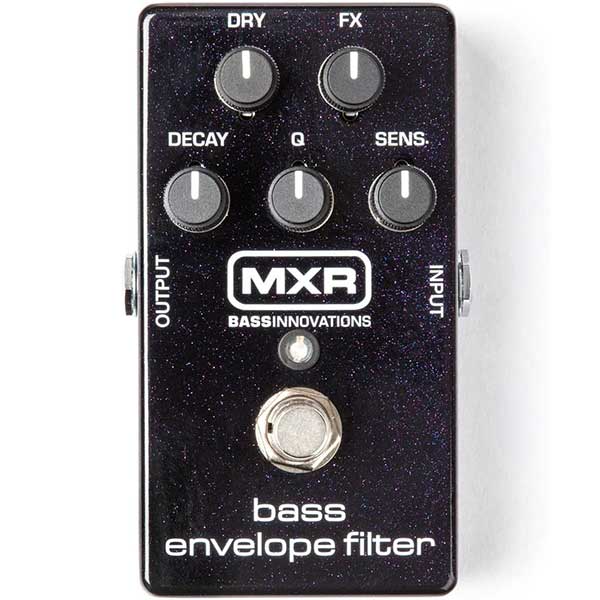
Estimated Price: $150
Pedal Type: Envelope Filter
My Review: The M82 offers funky analog, envelope filter sounds in a pedal that should have a spot on any bass player’s pedalboard. The Dry and FX controls let you dial in the perfect mix of wet/dry signal, ensuring that you keep your low end tight, while the Decay(varies your sweep from wide to narrow) and Q(sets the intensity of the filter effect) controls let you choose from a wide range of filter sounds. The Sensitivity control adjusts how hard you need to play for the filter to engage. It features a true bypass circuitry and over-voltage protection from faulty PSU’s.
Key Specifications:
- Analog envelope filter
- True bypass
- Separate Dry and FX control
- ¼” instrument in, ¼” out
- Power supply: 9V block battery or PSU

27. Electro-Harmonix Nano Bassballs Envelope Filter (Best Value)
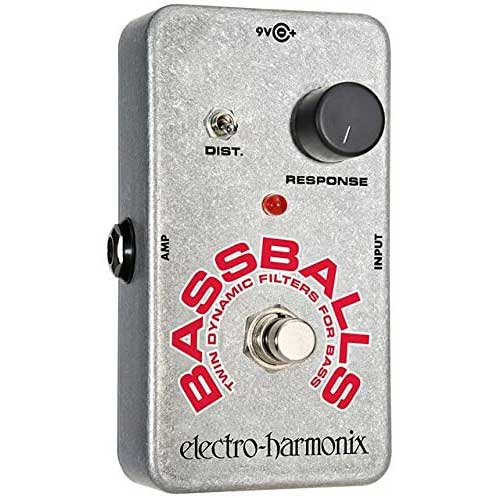
Estimated Price: $75
Pedal Type: Envelope Filter
My Review: The EHX BassBalls has been around forever, and for good reason. This nano version keeps all that you loved about the original and crams it into a Nano enclosure. The twin envelope filter uses 2 counter-sweeping filters to produce heaps of funky goodness. It only has a Response control adjusting the volume and sensitivity of the filter effect while a simple toggle switch is used to activate a fuzz/overdrive circuit adding a little more “hair” into the mix. The twin-filters can be adjusted via two internal trim pots and it also features a true bypass circuit.
Key Specifications:
- Analog envelope filter
- 2 sweeping filters, adjustable through internal trim pots
- True bypass
- ¼” instrument in, ¼” out
- Power supply: 9V block battery or PSU

Best Bass Chorus Pedals
28. Aguilar Chorusaurus (Best Overall)
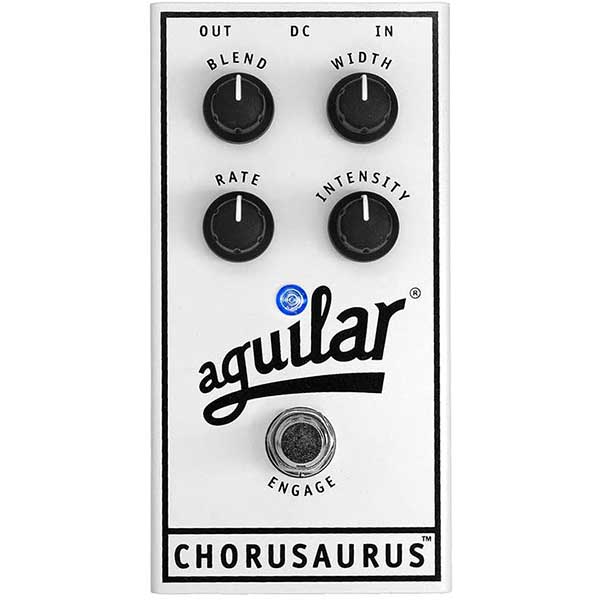
Estimated Price: $225
Pedal Type: Chorus
My Review: The Aguilar Chorusaurus is an analog stereo chorus pedal that delivers lush and shimmery sounds without compromise. It creates its magic through the use of the iconic bucket-brigade chips. The Width, Rate, and Intensity controls are used to dial in your tone, then you use the Blend control to restore your low end and you are ready to go. You have the option to run it in stereo with the use of a Y-cable from the ¼” out.
Key Specifications:
- All analog chorus designed for bass
- Bucket-Brigade chips produce shimmery chorus tones
- True bypass circuit
- ¼” instrument in
- ¼” mono and stereo out (using a Y-cable)
- Power supply: 9V battery or PSU

29. Electro-Harmonix Bass Clone (Best Value)
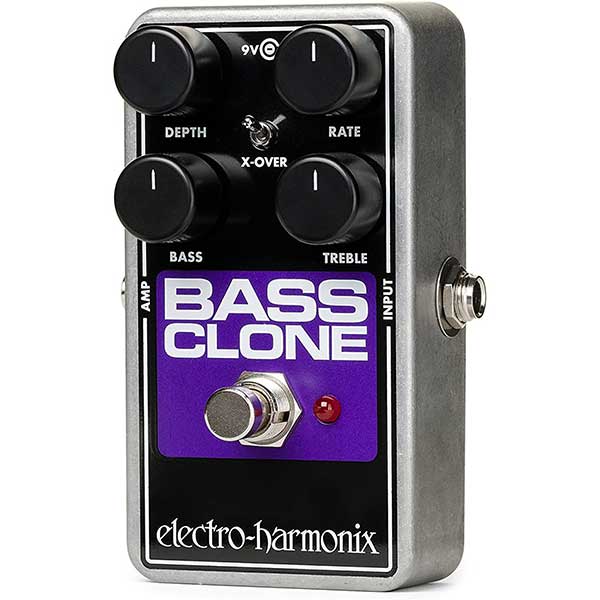
Estimated Price: $70
Pedal Type: Chorus
My Review: The EHX Bass Clone takes the classic Small Clone and optimizes it for the use with a bass guitar. Use the Depth and Rate controls to dial in your basic chorus sound, Treble will influence both the wet and dry signals, use the crossover switch to remove the now muddy low end of your wet signal then add your tight and punchy low end back using the Bass control that only affects your dry signal. The true bypass circuit will remove the effect from your signal chain when it is disengaged. If you are on a budget and want a chorus pedal to shine and shimmer with, give this EHX modern classic a try.
Key Specifications:
- Analog Bass Chorus
- Bass optimized Small Clone chorus
- ¼” instrument in, ¼” out
- Controls for Depth, Rate, Bass(affects dry signal only) and Treble(affects both wet and dry signals)
- X-over Switch removes the low end from the wet signal
- Power supply: 15mA@9V from a 9V block battery or PSU

30. MXR M83 Bass Chorus Deluxe
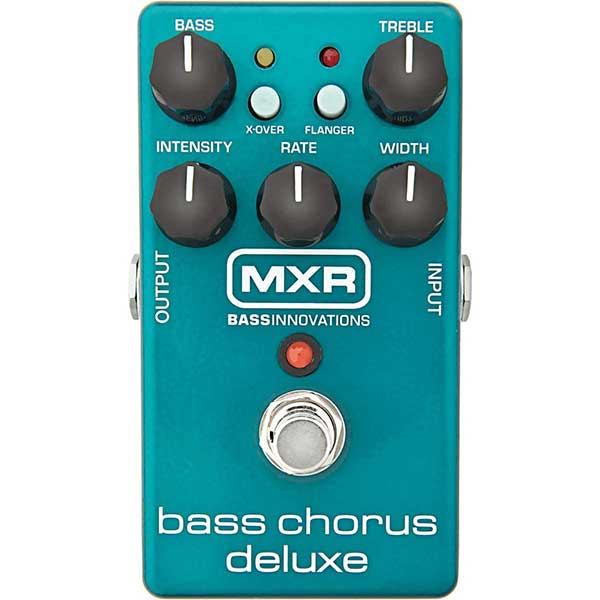
Estimated Price: $170
Pedal Type: Chorus
My Review: The M83 Bass Chorus Deluxe is an analog shimmer producing machine due to the Bucket-Brigade chips used in its construction. It features a broad range of tone shaping controls to which MXR added a crossover function and here’s the kicker, a flanger mode. It features Bass and Treble controls to fine tune your sound while the Intensity, Rate, and Width knobs control the character of the Chorus effect. The crossover function rolls off its modulation of frequencies starting at 100Hz, maintaining the low end while your highs shimmer away. Here you buy a great Chorus pedal and you’ll get a free flanger with it.
Key Specifications:
- Analog Bass Chorus
- Choose between Chorus and Flanger at the push of a button
- Crossover switch preserves your low end
- Stereo output can be toggled internally and needs a ¼” Y cable to function
- Power supply: 9V block battery or PSU

Choosing the Right Bass Pedal (Buying Guide)
What is a Bass Pedal?
In the most basic sense, a bass pedal is a small form factor electronic device, also known as a stompbox, designed to change the sound of your bass in interesting ways. Sometimes the changes are subtle as with compressors, at other times they are more dramatic as with a distortion pedal, but we’ll get to all the different pedal types later on. It all depends on the sound you are looking for and there are hundreds of flavors to choose from. For more basic facts about Bass effects pedals click here.
How Do They Work?
Stompboxes have straightforward layouts, an input – where you plug in your bass, an output – that connects to your amp, and a few knobs, making the search for the tone that tickles your creativity a piece of cake – settling on one is another matter. You also need a way to power your pedal either with a 9V Block Battery or from a power supply unit – PSU.
Guitar and bass pedals are very similar; Bass pedals are just tuned to work better with the low end frequencies. They will usually go in your signal chain between your bass and your amp although running them through the send/return of your amp is also an option.
Pedals come in two basic varieties analog and digital – one is not better than the other!!! – as some purists out there would have you believe. It’s just a matter of the technology employed. Analog pedals use basic electronic circuits to produce the desired effect while Digital pedals use algorithms and signal processors to achieve the same.
What to Look for When Buying a Bass Pedal?
As you are looking to buy a stompbox, expect to stomp on it quite a few times so construction is an important factor for most bass players out there. The majority of pedals are built using a sturdy aluminum enclosure, but not all, some use plastic enclosures for their effects. Footswitches and Potentiometers (Pots) are of greater concern, they being the most prone to fail.
Pedal manufacturers sometimes use the cheaper plastic shaft pots in their pedals, which do like to break off when enthusiastically tread upon while aiming for the on or off switch during a gig. The Footswitches are generally of decent quality and rarely fail from normal stomping use.
When you are adding a pedal to your signal chain, preserving your tone is LAW. The discussion here is True bypass vs. Buffered bypass and there are a lot of opinions on the subject. A True bypass sometimes called “hard bypass” disconnects the electronics of the pedal and connects your input and output jacks together, bypassing the pedal and running the signal straight through, in theory without altering your tone. This means that if your pedal loses its power source, the signal will still reach your amp, though slightly degraded. Buffered bypass is a solution to signal degradation which occurs when the signal from your bass passes through the cables and pedals to your amp. This degradation is largely reduced when using active pickups or electronics in your bass, but it is worsened the more pedals you add to your signal chain. In some cases, as with large pedalboards, a buffered bypass is a good way to preserve the tone of your instrument. It really all depends on the case in point: the type of bass and electronics inside of it, the length of your cables, and how many pedals you run the signal through until it reaches the amp. If you’re running your signal through a large pedalboard it is recommended that the first and last pedal be of the “Buffered” kind.
As you are now down with the basics let’s go through some pedal types and the features you are likely to encounter while shopping.
Tuner Pedals Explained
They do what they say they do – they let you tune your bass to the pitch you want, but they can do so much more.
Most tuners offer a plethora of displaying tuning modes, from chromatic – showing you the exact note you are playing on the chromatic scale, to strobe mode (which is not a true strobe tuner, just a strobe-like display) that lets you see how far off you are from a particular reference note with the help of a needle, and every colorful display variant in between. Just find the one you like and get on with tuning your bass.
If you are a bassist who likes acrobatic moves on stage or to experiment with different tunings then you are in luck. The latest addition to a basically stagnant pedal is the polyphonic capability, this mode makes it possible for a bass or guitar player (there are no special bass guitar tuners) to strum all the strings at once and check which ones are out of tune with a single glance. Light-emitting diodes or LEDs will light up on the display showing which strings need adjusting. This can be very useful during gigs when you don’t want to spend your time checking if you are in tune. The downside is slightly reduced accuracy and a pricier pedal so if you are on a budget you can skip the “polytuners” and get a regular old tuner. It will still do the job quite nicely and you will have some cash left over to invest in another pedal that really makes a difference to your tone.
The precision of a tuner is measured in “cents”. A cent represents one-hundredth of a semitone. It is commonly agreed that the human ear can perceive a change of five cents. Pedal tuners have an accuracy of +/-1 cent at the least, this means that you shouldn’t worry too much about precision.
Some tuners let you choose between True bypass and Buffered bypass which is a nice choice to have since the tuner should be the first pedal in your signal chain.
NOBODY should hear you while you tune your instrument; not your bandmates and especially not your audience, so tuning while the output is muted is something every tuner should have! If the tuner you are looking to buy doesn’t have this feature, better give it a pass – most have it though.
A big, bright and easy to read LED display is a must-have for a good tuner pedal since you will probably have to tune your bass on a dark stage at some point in time.
In recent years pedal makers have been offering “mini” versions of their standard stompbox sized tuner pedals. If you are running low on pedalboard real estate or if you just need a small tuner to throw in your gig bag, one of these minis might be a good idea.
When you are playing in a band with an acoustic instrument like a piano, that is not tuned to the standard 440Hz, being able to shift the reference frequency is a prerequisite. To aid in this scenario, worthwhile tuners let you choose the reference point from a range below and above 440Hz.
Preamps and EQ Pedals Explained
What is a bass Preamp and why do you need one
A preamplifier or “preamp” is a piece of electronic equipment used to increase the dB volume of your signal until it reaches the standard dB which all studio and live equipment work with, known as “line-level”. Simply put it makes your signal louder, preparing it for further processing by your other bass effects as the more you use in your signal chain, the more your signal drops. Due to this fact, you should place your bass preamp early in the signal chain.
In a bass specific context, you will probably use a preamp as a clean boost placed before your other pedals, but you can also use a bass preamp as a standalone tone-shaping tool as most of them combine an Overdrive and an EQ (equalizer) section.
When shaping your bass tone, the EQ will be your go-to. The most common types of EQ’s you’ll encounter are of the Parametric and Semi-Parametric kind. A parametric EQ chooses a set of frequency ranges like Bass, Mid, and Treble and lets you tweak each of them with individual knobs according to the slope or Q the manufacturer has set. A semi-parametric EQ lets you select the frequency you want to tweak with the Bass, Mid, and Treble knobs.
A good bass preamp should have the lowest noise ratio you can afford, adding little to no unwanted noise to your sound. Low noise usually means quality components and build, this in turn will drive up the price of the preamp. Another feature you’ll find on most well thought out bass preamps is the DI out, this enables you to plug directly into the mixing console of the PA system without the need of an amp – you just need your bass and your preamp and you are ready to rock.
Compressor Pedals Explained
In the simplest terms, a compressor will compress your sound, reducing the dynamic range of your sound making everything sound more even. It makes quiet sounds louder and loud sounds quieter. This is very useful with bass playing when switching between playing styles like from fingerstyle to slapping or when using effects that can alter your dynamic range like auto-wahs or synths. Adding a compressor to your setup will increase the sustain of your bass – it makes quiet sounds louder but any mistakes in your playing will also be more noticeable and because it squashes your sound into a narrower dynamic range your bass will be more easily heard when playing with a band (cutting through the mix).
A compressor uses 4 basic controls:
Threshold: How loud your signal gets before compression is applied.
Ratio: How much compression is applied when your signal reaches the threshold (ex: at a 4:1 ratio your input signal will have to increase by 4dB for the output to increase by 1dB)
Attack: How quickly the compressor begins to work
Release: How soon the compressor stops working after your signal dips below the threshold.
Overdrive and Distortion Pedals
To understand what an overdrive pedal is, we must first understand how it came to be. Overdrive originated with guitar players turning up their tube amps past their recommended operating volume until a natural clipping occurs, which causes the signal to distort. This clipping compresses and muddies the sound by cutting high and low frequencies alike, in a way most blues players have found appealing. Overdrive will increase your gain and will add sustain and harmonic overtones to your sound.
An overdrive pedal is a way to emulate this same process without using a pushed amp. It is commonly recommended that you place your overdrive pedal near the beginning of your signal chain. Overdriven bass sounds can be heard on many Hard Rock, Punk, Heavy Metal, and Hardcore tracks.
What is a distortion pedal and why do you need one
In contrast to overdrive, no one can be told what distortion is; because overdrive is distortion, and “distortion” is just a more extreme variant of the same effect. The distinction between the two is arbitrary at best and more modern pedals blur the lines, even more, offering more versatile gain controls. A distortion pedal will change the way your instrument sounds in a more dramatic way than overdrive.
Bass distortion features heavily with bands like The Who, Muse or Karnivool, and others, too many to name.
Octaver Pedals
An octaver is a type of effect that grabs your input signal and creates a synthesized signal one or more octaves higher or lower from the original signal. You can then mix it with the original signal or choose to play only the synthesized signal. The synthesized octave signal is created by halving (octave down) or doubling(octave up) the original frequency.
In the olden days, analog octavers offered only an octave-up and were quite prone to glitching. Recent iterations of this effect enable one or even two octaves down with a bass guitar, but playing below the 5th fret of the E string still glitches out most analog octavers. The solution to glitching is a modern digital octaver that samples your signal and applies processing to digitally change the pitch of your signal, even enabling you to play chords or adding multiple up or down octaves.
In essence, you need to choose between a digital or an analog pedal based on how you are going to use your octaver. If you’ll be playing single notes and are willing to overlook the occasional glitch – go with analog, but if you want multiple octaves or will play chords, then a digital octave is the way to go.
Envelope Filter Pedals Explained
A filter is a circuit that adjusts the volume levels of some or all frequencies that pass through it. An EQ is a set of filters chained together, a high-pass filter only lets the high frequencies pass, cutting the low ones. An envelope filter uses resonance to enhance certain frequencies depending on your playing dynamics – how hard you pluck your strings. Usually, an envelope filter is set to gradually open up as your signal gets louder, then after the signal peaks, it will gradually close again. The filtering effect being dependent on the way you play your bass, you can learn to play your filter pedal using your playing dynamics. Envelope filters are often described as producing vowel-like, screaming, or quacking sounds. You can listen to some envelope filters on bass in songs like Just Another Story by Jamiroquai or Fly Away by Lenny Kravitz.
Chorus Pedals Explained
Chorus is a type of modulation effect that will copy your signal multiple times, coloring the copies slightly and then playing them back but slightly delayed. The result is a full, shimmery ensemble of “bass voices” simulating the sound of multiple basses playing the same part. Usual controls for a chorus are Depth, Rate, and Tone. You use a chorus to thicken up your sound and adding that shimmery character, it is also a favorite of fretless bass players who don’t care too much about intonation, as the modulation of the chorus effect masks their shortcomings.

My name is Chris and I’ve had a passion for music and guitars for as long as I can remember. I started this website with some of my friends who are musicians, music teachers, gear heads, and music enthusiasts so we could provide high-quality guitar and music-related content.
I’ve been playing guitar since I was 13 years old and am an avid collector. Amps, pedals, guitars, bass, drums, microphones, studio, and recording gear, I love it all.
I was born and raised in Western Pennsylvania. My background is in Electrical Engineering, earning a Bachelor’s degree from Youngstown State University. With my engineering experience, I’ve developed as a designer of guitar amplifiers and effects. A true passion of mine, I’ve designed, built, and repaired a wide range of guitar amps and electronics. Here at the Guitar Lobby, our aim is to share our passion for Music and gear with the rest of the music community.
